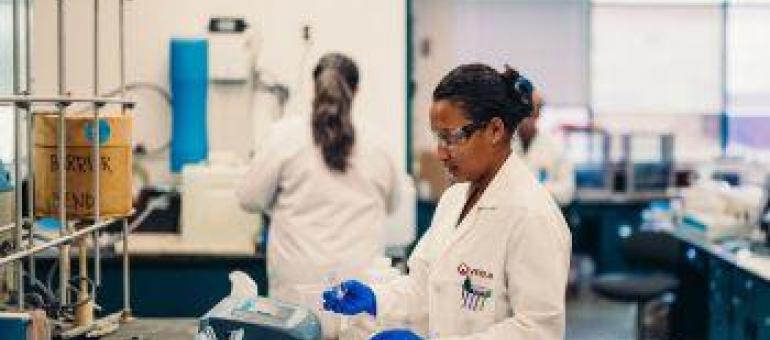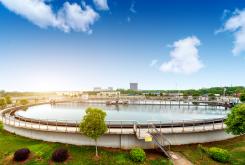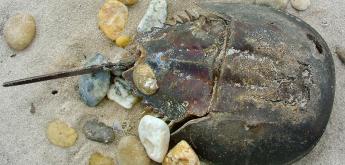National Engineers Week: Celebrating Veolia's Expertise in Addressing PFAS

Veolia's engineers are the brilliant minds behind our groundbreaking technologies and innovative solutions. On this National Engineers Week, we’re shining a spotlight on some of our engineers who work tirelessly to combat per- and polyfluoroalkyl substances (PFAS). PFAS are a group of synthetic chemicals that are resistant to heat, water, and oil. They are often referred to as "forever chemicals" because they do not break down easily in the environment.
Veolia has treated 24 billion gallons of water for PFAS worldwide and is committed to safely handling and disposing of contaminates in accordance with EPA-recommended methods. Our end-to-end PFAS management suite of solutions, BeyondPFAS, is designed to support organizations at every step of the process. We have decades of experience implementing and operating technologies that are scientifically proven and tailored to each project.
Our talented engineers developed these innovative solutions with a safer, cleaner future in mind, which aligns with Veolia’s GreenUp initiative and this year’s Engineers Week theme: “Design Your Future.” We wanted to learn more about what drives these dedicated experts, so we sat down with a few (Carol Walczyk, Elaine Towe, John Peichel, Seamus McDonald and Sophie Lindegaard) to learn more about how they tackle the PFAS challenge and inspire the next generation of engineers to find innovative and sustainable solutions.
What inspired you to become an engineer?
- Carol: My grandfather and father were engineers, and my mom would have been an engineer, given the opportunity. My parents strongly encouraged me and my brothers to study engineering as a great basis for any career, but I am the only one who stayed in the engineering world. I loved solving problems, and communicating about them in ways that even non-engineers could understand. My dad spent his entire career working in the New York City water and wastewater utility, so it was a natural progression into environmental engineering for me. I am also proud that both of my children are successful engineers.
- Elaine: I always loved science and math in school. My Dad was a Ph.D. chemist and when I applied to universities, he said "why not try engineering?" And that was it. I loved it from day one. I loved and still love the practical nature of being an engineer - solving real problems using sound principles and approaches. We help keep the people and our communities safe and there is great pride in doing this important work.
- John: Growing up on a farm in Minnesota, I enjoyed working with machines and was always fascinated by how things work and loved building and fixing things.My hands-on experience and interest in science inspired me to pursue a degree in mechanical engineering. During my studies, engaging in lab projects shifted my focus, ultimately leading me to earn a degree in Physics and gain Chemistry lab experience. This path led to my first role as an Applications Engineer at Osmonics.
- Seamus: I studied physics because I was curious about the universe and wanted to know more about how things in everyday life worked. Engineering seemed like a great way to apply that knowledge!
- Sophie: When I was young, I wanted to have a job which was operational and impactful. As I was good at Maths and Physics, engineering was a good fit. I am educated as an Agricultural Engineer but it was a postgraduate program in Water Treatment in Spain that drove me to a career in the environmental field. Today I realized that I have been lucky to "fall" in the fascinating and gratifying environmental industry.
What role do you play at Veolia to combat PFAS?
- Carol: As a leader of the engineering team supporting facility operations across North America, and as a past leader of the water quality and compliance team, I support Veolia teams around the world for tracking PFAS regulations, identifying appropriate treatment, and evaluating and supporting innovative technologies. I also work extensively with professional organizations such as AWWA to develop and share knowledge on this topic across the various industries we work in.
- Elaine: I am a Subject Matter Expert working in North American Services. One of my key areas of expertise is the treatment of PFAS. I provide technical guidance to our sales, commercial, and field teams regarding PFAS treatment using granular activated carbon (GAC), Ion Exchange, and reverse osmosis (RO) for our mobile solutions, including the determination of any necessary pretreatment to ensure successful operation. I am also deeply involved with applying our LEAPfas product to opportunities - both capital and mobile. Our LEAPfas product consists of pressurized vessels with unique design features that enable operating cost savings and enhance the safety of operators.
- John: At Veolia, I am the Growth Initiative Leader for PFAS in the Water Tech Zone. My role involves leading and coordinating our activities along with researching and optimizing PFAS treatment technologies. As part of a cross-functional team at Veolia, I collaborate closely with colleagues and work with our customers to develop and implement innovative solutions for PFAS remediation.
- Seamus: I help customers understand what PFAS are, some methods for detecting them, what certain reporting and detection limits are, and how to treat water containing PFAS from their municipal water supply, particularly using reverse osmosis.
- Sophie: As Innovation Project Manager, I work at finding the best solutions to treat PFAS in water, wastewater and biosolids. I organize different programs of tests on our proprietary micropollutant technologies in order to evaluate their performance for PFAS treatment. My other mission is to investigate the emerging technologies able to achieve full degradation of the PFAS, i.e. mineralization.
What are the most common challenges that engineers in our industry face? What are some challenges that you are facing in your current role?
- Carol: Regulations are evolving in a different way than they did early in my career, being driven by public concern and media exposure that often outpaces the development of effective technologies to meet them. Engineers are trained to rely on well-proven science, and to communicate with the public once a problem is completely solved, but we often don’t have that luxury now. Working in the operations sector, we need to be transparent with the public about the challenges we are all facing together. We also have tremendous workforce needs in both engineering and operations, with many of our experienced professionals approaching retirement and more demand than ever for talented staff.
- Elaine: Engineers play a critical role in the design and development of technical solutions for those in need. They must ensure safety above all else and see that a robust, practical solution is put in place, which can sometimes be tough as there are inherently pressures to minimize costs and increase the speed of implementation. In my role, this is something that I always try to keep balanced - to consider everyone's perspective to come up with the best solution for our customers, without compromising on technical design.
- John: Engineers in the environmental sector often face challenges such as rapidly evolving regulations, the complexity of contaminant mixtures, and the need for cost-effective solutions that can be scaled up. In my current role, one of the biggest challenges is staying ahead of the curve with emerging PFAS compounds and understanding their behavior in different environmental contexts. Additionally, balancing the technical aspects of treatment with economic and social considerations is a constant challenge, as we strive to deliver solutions that are not only effective but also cost-effective and sustainable.
- Seamus: With regulations constantly evolving, emerging contaminants will become an important topic of discussion. Understanding what these contaminants are, how to detect them, and how to manage them is a full time job. This is the type of expertise our customers look to us for.
- Sophie: A big challenge for me is to efficiently follow all the R&D and the start-up developments on PFAS treatment because there are so many developments in that field that it is easy to be overwhelmed by them. But I can rely on Veolia's network to keep updated.
What are some of the most promising emerging technologies for PFAS remediation that engineers are developing?
- Carol: The strong and urgent interest in PFAS mitigation has led to tremendous innovation in this space. For water, tried-and-true treatments such as GAC, anion exchange and RO continue to be the most effective options available to us, but there are many promising technologies to optimize those processes, concentrate waste streams to manageable volumes, and provide safe disposal of those waste streams. These include foam fractionation, high recovery RO, and high temperature incineration.
- Elaine: We are in exciting times! There is ongoing work on emerging technologies for PFAS treatment for separation (i.e. flotation), capture (i.e. novel adsorbents), and destruction (i.e. foam fractionation, plasma, catalytic electrochemical oxidation and sonolysis), as well as advancements in analytical testing. Many of these technologies are in various stages of development and commercialization, such as bench or pilot testing. As we continue to collect data (i.e.total cost of ownership, scalability, ease of operation), this will help guide us on how to determine the optimum technology for each application.
- John: For treatment, our own LEAPfas capture solution and high-recovery RO options are key technologies in PFAS treatment but also in enabling new technologies like advanced oxidation processes, such as electrochemical oxidation and plasma, which have shown potential in breaking down PFAS molecules. These technologies, combined with innovative approaches like thermal treatment and bioremediation, offer hope for more effective and sustainable PFAS management.
- Seamus: There are many promising emerging technologies for PFAS remediation. Although it is not an emerging technology, reverse osmosis can be used as a pre-treatment step to concentrate PFAS before applying more intensive treatment methods like electrochemical oxidation or supercritical water oxidation. Alternatively, it can serve as a polishing step after other treatment methods to ensure the highest possible removal rates
- Sophie: Besides the common technologies used to separate the PFAS from a specific matrix, I see some concentration technologies like foam-fractionation as very promising for decreasing the volume of residues for disposal or full degradation. Our job is to investigate and find the most optimized technology among the many solutions. For full degradation, the technologies are not completely mature but my shortlisting would be from advanced oxidation processes to incineration processes.
What advice would you give to young people interested in pursuing an engineering career to help solve environmental challenges like PFAS contamination?
- Carol: Don’t be deterred from engineering if you don’t think you’re a math and science whiz. We are problem solvers, and math and science are just among the tools we use. Look into your local STEM programs and organizations such as the Society of Women Engineers, or reach out to an engineer you know, to help you understand the wide variety of things that engineers really do.
- Elaine: I would say if you are passionate about protecting our environment, for not only ourselves but for future generations, and you like solving problems, this field of work may be for you. PFAS treatment is an emerging field, where we are all learning together; both within our teams and overall as a water treatment industry. We need bright, creative minds, who can collaborate together to tackle these important challenges!
- John: My advice to aspiring engineers is to cultivate a strong foundation in the sciences and stay curious about the world around you. Embrace interdisciplinary learning, as solving complex environmental challenges requires knowledge from various fields. Seek out internships and hands-on experiences (like lab studies and field pilots) to apply your skills in real-world settings. Most importantly, remain passionate and persistent. The path to innovation is often challenging, but your efforts can lead to meaningful change. Remember, engineering is not just about building things—it's about building a better future for our planet and its inhabitants.
- Seamus: Do research in your field of interest. There are always ways to create or improve upon methods for handling environmental challenges!
- Sophie: I would recommend getting a robust knowledge in chemistry and engineering matters, to do internships in environmental companies and to join Veolia!







